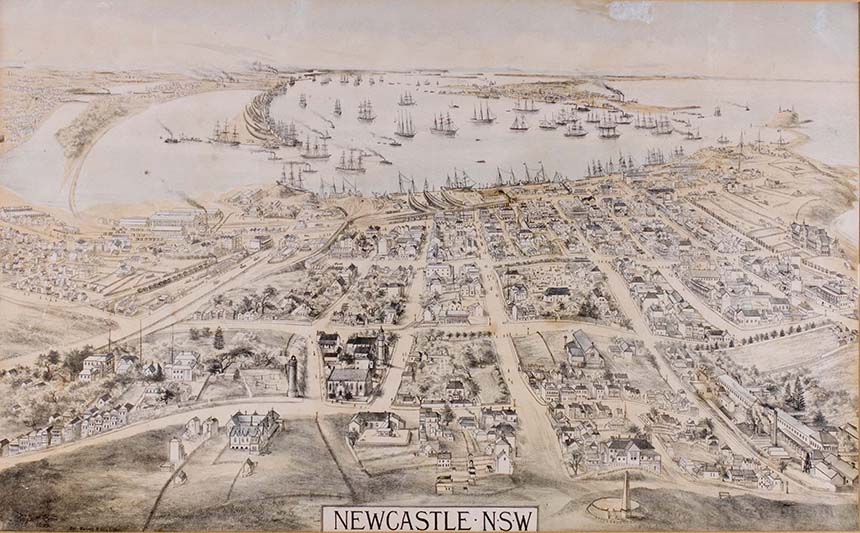
Archaeology and Development

Archaeology is an evidence-based discipline which seeks to explain the past through the study of physical evidence. Many aspects of societies, environments, cultures and place, from various times in human history are studied, using excavated evidence, objects, and other cultural material. Historical archaeology deals specifically with the archaeology of those areas within which there are written records in addition to surviving archaeological evidence. When used together, historical and archaeological evidence reveals a more complete understanding of the past.
The archaeological resource of the Newcastle city centre dates from the earliest period of European settlement in Australia. Newcastle is the third oldest urban settlement after Sydney and Parramatta. The city’s archaeological resources yield information not only about Newcastle itself, but have the potential to contain information about the early colony and the experience of convict life that can contribute to understandings about life in colonial Australia and of how it was governed and administered, including encounters with the local Aboriginal population.
The Newcastle Archaeological Management Strategy 2015 found that while Sydney, Hobart and Brisbane, as well some small centres such as Port Macquarie, were established as penal colonies, the level of archaeological survival was found to be lower than the survival rate attributed to Newcastle. The NAMP 1997 determined that on the basis of the low rates of site amalgamation and redevelopment and few buildings with basements, the potential for remains to survive was much higher than those cities of similar age and origin. As such, the archaeological resource of the Newcastle city centre was determined to be potentially of outstanding significance.
Frequently asked questions
Sites with known archaeological potential in Newcastle are identified and protected either:
- As heritage items by Part 1 and Part 3 of Schedule 5 of the Newcastle Local Environmental Plan 2012;
- By the NSW State Heritage Inventory (SHI); and/or
If your property is identified by the above, then it is an archaeological site.
To check if your property is a site of known or potential historical archaeology, use City of Newcastle's online mapping tool Aboriginal Cultural Heritage and Historical Archaeology App.
- Refer to Newcastle Archaeological Management Plan 1997 and Newcastle Archaeological Management Plan Review 2013 for more details on archaeological sites identified by the App.
- Refer to Schedule 5 and associated heritage map sheets of the Newcastle Local Environmental Plan 2012 for heritage listed archaeological sites.
- More details on archaeological sites listed by the Newcastle Local Environmental Plan 2012 and declared Aboriginal Places are available by using the NSW State Heritage Inventory (SHI).
- For a detailed search of declared Aboriginal Places and other sites of Aboriginal cultural significance, use the Aboriginal Heritage Information Management System (AHIMS).
The NSW Heritage Act 1977 affords automatic statutory protection to relics that form archaeological deposits or part thereof. The Act defines relics as:
‘Relic means any deposit, artefact, object or material evidence that:
(a) relates to the settlement of the area that comprises New South Wales, not being Aboriginal settlement, and
(b) is of State or local heritage significance’
The Act prevents the excavation or disturbance of land for the purpose of discovering, exposing or moving a relic, except by a qualified archaeologist to whom an excavation permit has been issued by the Heritage Council of NSW.
The Heritage Council of NSW, assisted by Heritage NSW, is the regulator of archaeological relics and archaeological sites across New South Wales. In 1996 it published the heritage manual for Assessing Significance for Historical Archaeological Sites and ‘Relics’ which outlines specific criteria for addressing the significance of an item.
The NSW Heritage Act 1977 defines 'relics' as:
‘Relic means any deposit, artefact, object or material evidence that:
(a) relates to the settlement of the area that comprises New South Wales, not being Aboriginal settlement, and
(b) is of State or local heritage significance’
There is no definition in the Act for ‘work’.
Essentially ‘works’ are structures. They are ‘public works’ that are not buildings e.g. bridges, dams, roads, etc. ‘Relics’ are chattels. So there is a difference of scale.
An archaeological site will generally contain a mixture of structural remains from demolished buildings and works, plus the ‘relics’ including artefacts and deposits.
For example, a well on a site would be a ‘work’ but the artefacts inside it would be ‘relics’ and be managed as such under the Act via an excavation permit or exception.
This is explained further in the NSW Heritage Branch guideline Assessing Significance for Historical Archaeological Sites and Relics.
The Newcastle Development Control Plan (DCP) applies to development that consists of excavation or site disturbance. This section provides aims, objectives and controls regarding archaeological management and should be read in conjunction with the Newcastle Archaeological Management Plan 1997, prepared by Suters Architects. The information contained in this 1997 plan has been supplemented by the Newcastle Archaeological Management Plan Review 2013, prepared by Edward Higginbotham & Associates.
The Newcastle Archaeological Management Plan Review 2013, and the original Newcastle Archaeological Management Plan 1997, were prepared to give an indication of the nature and extent of historical archaeological resources in central Newcastle and to provide a framework to ensure historical archaeological resources are recognised and integrated into the urban planning framework.
While the NAMP has no legal status, it is a planning tool that provides an overview of areas that require the consideration of archaeological issues in conjunction with any development applications. Both of these documents are available for viewing in the Local Studies Section of Newcastle Region Library and are also listed below.
Newcastle Archaeological Management Plan 1997, prepared by Suters Architects
- Volume 1 Study Report (PDF)
- Volume 2 Inventory Datasheets (PDF)
- Volume 3 Map and Text References (PDF)
The Newcastle Archaeological Management Plan 1996/1997 map shows locations of indicative archaeological sites (PDF)
Newcastle Archaeological Management Plan Review 2013, prepared by Edward Higginbotham & Associates
- Volume 1 - Site survey, significance, conservation and management (PDF)
- Volume 2 - Inventory (PDF)
- Volume 2 - Appendices 1 and 2 (PDF)
- Volume 3 - Historical Overview (PDF)
For the archeological sites identified in the Newcastle Archaeological Managment Plan 1997 and Newcastle Archaeological Management Plan Review 2013, use City of Newcastle's online mapping tool Aboriginal Cultural Heritage and Historical Archaeology App.
It is your responsibility to seek the necessary approval from the Heritage Council of NSW under the Heritage Act 1977, separate to City of Newcastle's Development Assessment process.
You will need to apply and be granted an excavation permit by the Heritage Council of NSW and meet certain requirements before the activity can take place. Visit the Heritage NSW website for further details on the excavation permit process and how to apply.
In accordance with the Heritage Act 1977, if during the course of any ground disturbance works previously unknown historical archaeological material or relics are discovered, all work in the area of the discovery should cease immediately and Heritage NSW be contacted on 02 9873 8500 or heritagemailbox@environment.nsw.gov.au, to determine an appropriate course of action prior to the recommencement of work in the area of discovery. Additional assessment and approval may be required prior to works continuing in the affected area(s) based on the nature of the discovery. Severe penalties can be applied to corporations or individuals who are found to be in breach of the Act.
This applies to all land in NSW, including sites where a section 60 or section 140 approval has already been issued by the Heritage Council of NSW under the Heritage Act 1977.











